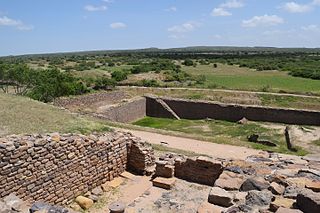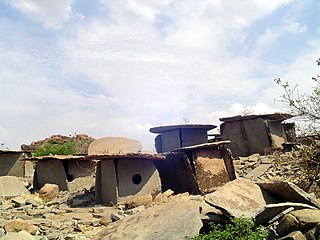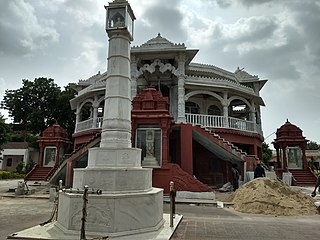
Sir Robert Eric Mortimer Wheeler CH CIE MC TD was a British archaeologist and officer in the British Army. Over the course of his career, he served as Director of both the National Museum of Wales and London Museum, Director-General of the Archaeological Survey of India, and the founder and Honorary Director of the Institute of Archaeology in London, in addition to writing twenty-four books on archaeological subjects.

Rakhigarhi or Rakhi Garhi is a village and an archaeological site belonging to the Indus Valley civilisation in Hisar District of the northern Indian state of Haryana, situated about 150 km northwest of Delhi. It was part of the mature phase of the Indus Valley Civilisation, dating to 2600-1900 BCE. It was among the largest settlements of the ancient civilisation, though most of it remains unexcavated. The site is located in the Ghaggar River plain, some 27 km from the seasonal Ghaggar river. Initial excavations at the site happened in the 1960s, followed by further excavations in the late 1990s, however more sustained excavations have taken place in the past decade.

The Archaeological Survey of India (ASI) is an Indian government agency that is responsible for archaeological research and the conservation and preservation of cultural historical monuments in the country. It was founded in 1861 by Alexander Cunningham who also became its first Director-General.

Kalibangān is a town located at 29.47°N 74.13°E on the left or southern banks of the Ghaggar in Tehsil Pilibangān, between Suratgarh and Hanumangarh in Hanumangarh District, Rajasthan, India 205 km. from Bikaner. It is also identified as being established in the triangle of land at the confluence of Drishadvati and Sarasvati Rivers. The prehistoric and pre-Mauryan character of Indus Valley civilization was first identified by Luigi Tessitori at this site. Kalibangan's excavation report was published in its entirety in 2003 by the Archaeological Survey of India, 34 years after the completion of excavations. The report concluded that Kalibangan was a major provincial capital of the Indus Valley Civilization. Kalibangan is distinguished by its unique fire altars and "world's earliest attested ploughed field". It is around 2900 BC that the region of Kalibangan developed into what can be considered a planned city.

Arikamedu is an archaeological site in Southern India, in Kakkayanthope, Ariyankuppam Commune, Puducherry. It is 4 kilometres (2.5 mi) from the capital, Pondicherry of the Indian territory of Puducherry.
Braj Basi Lal was an Indian writer and archaeologist. He was the Director General of the Archaeological Survey of India (ASI) from 1968 to 1972 and has served as Director of the Indian Institute of Advanced Studies, Shimla. Lal also served on various UNESCO committees.
Gregory Louis Possehl was a professor emeritus of anthropology at the University of Pennsylvania, United States, and curator of the Asian Collections at the University of Pennsylvania Museum of Archaeology and Anthropology. He was involved in excavations of the Indus Valley civilization in India and Pakistan since 1964, and was an author of many books and articles on the Indus Civilization and related topics. He received his BA in anthropology from the University of Washington in 1964, his MA in anthropology from the University of Washington in 1967, and his PhD in anthropology from the University of Chicago in 1974. He conducted major excavations in Gujarat, Rajasthan (Gilund), and in January 2007, began an excavation at the UNESCO World Heritage site of Bat in the Sultanate of Oman.

Dholavira is an archaeological site at Khadirbet in Bhachau Taluka of Kutch District, in the state of Gujarat in western India, which has taken its name from a modern-day village 1 kilometre (0.62 mi) south of it. This village is 165 km (103 mi) from Radhanpur. Also known locally as Kotada timba, the site contains ruins of a city of the ancient Indus Valley civilization. Earthquakes have repeatedly affected Dholavira, including a particularly severe one around 2600 BC.
The Archaeology of Ayodhya concerns the excavations and findings in the Indian city of Ayodhya in the state of Uttar Pradesh, much of which surrounds the Babri Mosque location.

Pataliputra, adjacent to modern-day Patna, was a city in ancient India, originally built by Magadha ruler Ajatashatru in 490 BCE, as a small fort near the Ganges river. Udayin laid the foundation of the city of Pataliputra at the confluence of two rivers, the Son and the Ganges. He shifted his capital from Rajgriha to Pataliputra due to the latter's central location in the empire.

The Dashavatara Temple is an early 6th century Vishnu Hindu temple located at Deogarh, Uttar Pradesh which is 125 kilometers from Jhansi, in the Betwa River valley in northern-central India. It has a simple, one cell square plan and is one of the earliest Hindu stone temples still surviving today. Built in the Gupta Period, the Dashavatara Temple at Deogarh shows the ornate Gupta style architecture.

The Bateshwar Hindu temples are a group of nearly 200 sandstone Hindu temples and their ruins in north Madhya Pradesh in post-Gupta, early Gurjara-Pratihara style of North Indian temple architecture. It is about 35 kilometres (22 mi) north of Gwalior and about 30 kilometres (19 mi) east of Morena town. The temples are mostly small and spread over about 25 acres (10 ha) site. They are dedicated to Shiva, Vishnu and Shakti - representing the three major traditions within Hinduism. The site is within the Chambal River valley ravines, on the north-western slope of a hill near Padavali known for its major medieval era Vishnu temple. The Bateshwar temples were built between the 8th and the 10th-century. The site is likely named after the Bhuteshvar Temple, the largest Shiva temple at the site. It is also referred to as Batesvar temples site or Batesara temples site.
Anant Sadashiv Altekar was a historian, archaeologist, and numismatist from Maharashtra, India. He was the Manindra Chandra Nandy's Professor and Head of the Department of Ancient Indian History and Culture at Banaras Hindu University in Varanasi, India, and later the director of the Kashi Prasad Jayaswal Research Institute and University Professor of Ancient Indian History and Culture at the Patna University, both in Patna, India.

The Lion Capital of Ashoka is the capital, or head, of a column erected by the Mauryan emperor Ashoka in Sarnath, India, c. 250 BCE. Its crowning features are four life-sized lions set back to back on a drum-shaped abacus. The side of the abacus is adorned with wheels in relief, and interspersing them, four animals, a lion, an elephant, a bull, and a galloping horse follow each other from right to left. A bell-shaped lotus forms the lowest member of the capital, and the whole 2.1 metres (7 ft) tall, carved out of a single block of sandstone and highly polished, was secured to its monolithic column by a metal dowel. Erected after Ashoka's conversion to Buddhism, it commemorated the site of Gautama Buddha's first sermon some two centuries before.

Hirebenakal or Hirébeṇakal or Hirébeṇakallu is a megalithic site in the state of Karnataka, India. It is among the few megalithic sites in India that can be dated to the 800 BCE to 200 BCE period. The site is located in the Koppal district, some 10 kilometres (6.2 mi) west of the town of Gangavati and some 35 kilometres (22 mi) from Hospet city. It contains roughly 400 megalithic funerary monuments, that have been dated to the transition period between Neolithic period and the Iron Age. Known locally as eḷu guḍḍagaḷu, their specific name is moryar guḍḍa. Hirebenakal is reported to be the largest necropolis among the 2000 odd megalithic sites found in South India, most of them in the state of Karnataka. Since 1955, it has been under the management of the Dharwad circle of the Archaeological Survey of India (ASI). On May 19, 2021, it was proposed that Hirebenakal be made a UNESCO World Heritage Site.

Hasmukh Dhirajlal Sankalia was an Indian Sanskrit scholar and archaeologist specialising in proto- and ancient Indian history. He is considered to have pioneered archaeological excavation techniques in India, with several significant discoveries from the prehistoric period to his credit. Sankalia received the Ranjitram Suvarna Chandrak award in 1966. And also received Padma Bhushan in the year 1974.

Rao Bahadur Kashinath Narayan Dikshit was an Indian archaeologist who served as Director-general of the Archaeological Survey of India (ASI) from 1937 to 1944.

Bhumara Temple, sometimes called Bhumra, Bhubhara or Bharkuleswar, is a 5th or 6th-century Gupta era Hindu stone temple site dedicated to Shiva near Satna, in the Indian state Madhya Pradesh. The temple has a square plan with a sanctum and Mandapa. While much of it is in ruins, enough of the temple structure and works of art have survived for scholarly studies. The temple is notable as one of the early examples of an architecture that included an enclosed concentric pradakshina-patha. Like other early Gupta era Hindu temples, it includes a decorated entrance to the sanctum flanked by Ganga and Yamuna goddesses, and intricately carved sculptures.

Jain Basadi complex in Halebidu, Hassan district consists of three Jain Basadis dedicated to the Jain Tirthankars Parshvanatha, Shantinatha and Adinatha. The complex is situated near Kedareshwara temple and Dwarasamudra lake. These temples were constructed in the 12th century during the reign of Hoysala Empire along with Kedareshwara temple and Hoysaleswara Temple have been proposed to be listed under UNESCO World Heritage Site. The temple complex also includes a step well called Hulikere Kalyani.

Bijolia Parshvanath Temple or Tapodaya Teerth Kshetra is a Jain pilgrimage center located in Bijolia town in Bhilwara district of Rajasthan.















